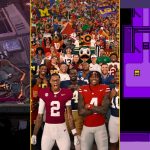They aren’t all terrible, surprisingly enough.
It’s no secret that licensed games have a reputation for… let’s charitably call it mediocrity. But they’re not all soulless tie-ins desperate to capitalize on the success of whatever IP the developer happens to have landed. After all, for every infamous bomb like E.T. or Colonial Marines, there’s an Arkham series or The Witcher; and to that end, here are nine licensed games that were actually pretty solid, and five that, well… weren’t.
The Good
Scott Pilgrim vs The World (2010)
Releasing loosely alongside the Edgar Wright movie based on the manga of the same name, Ubisoft’s Scott Pilgrim vs The World: The Game was a retro-ey beat ‘em up that pit you and up to three friends against all seven of Ramona Flowers’s seven evil exes – and a bunch of random thugs, club kids and ninjas – all in a style that mixed the manga with some of our favorite old-school side scrollers.
The Simpsons: Hit & Run (2003)
America’s favorite dysfunctional TV family are no strangers to licensed games, and none are better than 2003’s Hit & Run. Capitalizing on the success of open-world driving games like GTA and Driver, Hit and Run may not offer a geographically accurate recreation of Springfield, but it’s chock full of references horrifying 3D renders of your favorite characters for you to meet… and then run over.
Jedi Knight (Series)
There are lots of Star Wars games. Some have been truly awful, but the Jedi Knight series still sits among the best licensed game series of all time. A sequel to the 1995 Doom clone Dark Forces, the first Jedi Knight took series hero Kyle Katarn – the real hero who stole the first death star plans – from definitely-not-just-a-knockoff-Han-Solo to a full-fledged Jedi Master and good buddy to Luke Skywalker himself. It was one of the first games that allowed us to use a lightsaber, and arguably did the best job of enabling our force-based power fantasies out of any Star Wars game to date. It’s just a real shame that they erased Kyle’s legacy with Rogue One.
South Park: The Stick of Truth (2014)
With series creators Trey Parker and Matt Stone lending both their voices and their wits to the development of this turn-based RPG, it’s no surprise it wasn’t a flop. About as close as you could get to actually entering an episode of the show, The Stick of Truth let you become a citizen of South Park in a way nothing had before.
Goldeneye (1997)
The great granddaddy of console shooters, 1997’s Goldeneye cemented it’s spot in the gaming pantheon with then state-of-the-art graphics an gameplay and ushered in a new era of split-screen multiplayer that proved that an FPS on home consoles was no longer a pipe dream. Sure, its success may have heralded decades of bad Bond games to come, and resulted in untold numbers of fights starting over who did or didn’t get to play as Oddjob, but we’ll never forget our first.
Def Jam: Fight For New York (2004)
Some licensed games provide faithful recreations of their IP’s most iconic moments and characters. Def Jam: Fight For New York is not one of them. Instead, this takes all of your favorite stars of the hip-hop and rap scene and makes them fight, and casts them in a bizarre-yet-really-compelling story about two gangs fight to control Manhattan. It’s not a formula that you might expect to work, but it does – and you also get to play as Snoop Dogg or ICE-T who are both also ninjas, and how could that possibly be bad?
TellTale’s The Walking Dead (2011)
Telltale’s The Walking Dead may not have ended as strongly as it began, but man we’ll never forget that first season. Clementine and Lee proved to the modern age that you could tell a story in an existing world without relying on famous characters or plot hooks to prop it up, and even introduce new characters who become just as iconic as their silver-screened counterparts.
X-Men Origins: Wolverine (2009)
The movie may have been a godawful mess, but the tie-in game for X-Men Origins: Wolverine is secretly one of the best superhero games out there. It nails the idea of what it means to control Wolverine better than any game before it, right down to the regenerating wounds and the absurdly violent nature of his powers. You can even unlock his classic yellow and blue outfit to really make that “snikt” pop.
Mad Max (2015)
Whether because it launched on the same day as one of the biggest releases in the history of gaming, or simply because people were just Road Warrior-ed out after that year’s blockbuster Fury Road, Avalanche’s Mad Max remains one of the most criminally overlooked games of the generation. Its take on the world after the Water Wars offered a beautifully rendered hellscape, some excellent customization and reward systems, and unparalleled vehicular combat. If anyone from Warner Brothers is reading this, I beg you: please give Avalanche the chance for a sequel, and throw in that cool Nemesis system of yours.
The Bad & The Ugly
Street Fighter: The Movie: The Game (1995)
The movie may be so bad it’s good, but the game based on the movie based on the game is, unsurprisingly, just bad. Its developers weren’t even the same as the original game, rather a company whose biggest name to date had been Duck Tales on the Apple 2. While there was some novelty to being able to fight Golden Globe winner Raul Julia as Jean-Claude Van Damme, Blanka was just a white dude in cargo shorts and that feel like a pretty appropriate analogy for this game.
Superman 64 (1998)
Have you ever wanted to be the man of steel? Well, now you can! Experience all the power of the Last Son of Krypton like… flying through rings and… flying through… more… rings. And punching unrendered character models. Seriously, riddled with bugs and poorly designed from top to bottom, Superman 64 may be the worst superhero game ever made.
The Walking Dead: Survival Instincts (2013)
Unfortunately, not all of the Walking Dead games have been gems. In fact, most of them have been decidedly sub-par – none more than 2013’s Survival Instincts. Despite featuring the voice and likeness of both Michael Rooker and Norman Reedus, the game drowned in its muddy graphics and buggy, overly simplistic mechanics. There are far better ways to survive the zombie apocalypse than this.
Rambo: The Video Game (2014)
If there’s one movie franchise you’d think would be easy to translate into at least a passable FPS, it’d be Rambo – right? Welp, apparently not, as this 2014 – yes, that’s two-thousand-and-fourteen, for a Rambo game – is just a super-boring rail shooter like you’d find in a bowling alley arcade in the mid ’90s, except you had to pay 60 dollars for it and it didn’t even work right with your Xbox Controller or Mouse & Keyboard setup. At some point, I’d rather just go bowling.
Godzilla (2015)
You’d think a game about an absurdly large radioactive dinosaur that spends its days destroying cities and duking it out with other monsters and robot versions of itself would be a sure-fire good time, but you’d be wrong. 2015’s Godzilla game had weird, clunky controls, moved at a snail’s pace and looked like it should have come out on the PS2. If you were looking for a game that replicated the feeling of being a sweaty teamster in a rubber suit, this is it – but that’s about as close to King of the Monsters as it’ll take you.
What are some of your favorite licensed games? What about the ones that missed the mark? There are, of course, a bunch more that didn’t end up on this list for one reason or another, so let us know in the comments below!
JR is IGN’s Senior Features Editor, and might be problematically invested in getting a Mad Max sequel. He’s definitely mentioned it a bunch on Twitter.





















-768x300.jpeg)

